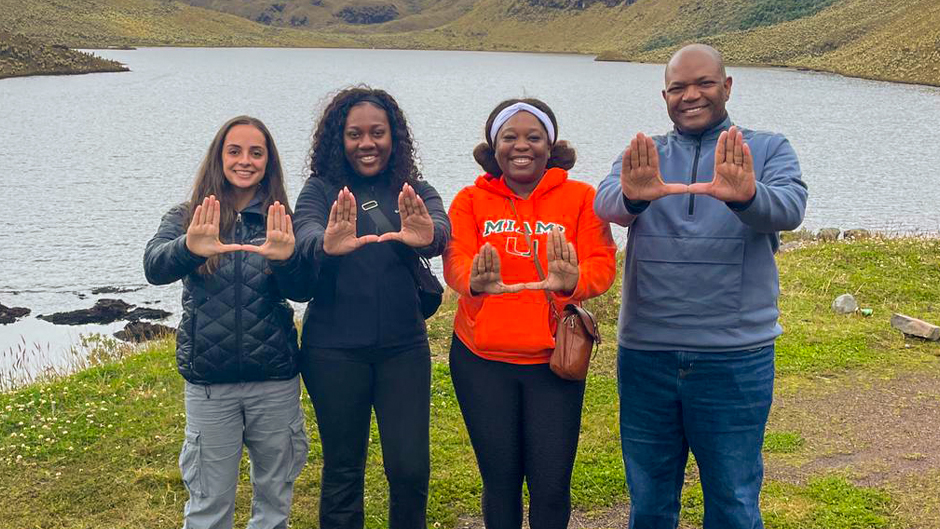In the town of San Francisco de Caldera in northwest Ecuador, the “animero” is an elder who leads prayers during funerals and holds special rituals during religious holidays to honor the ancestral spirits in ceremonies that marry Catholic and African traditions.
For the many residents of Caldera—most of them Afro Ecuadoreans who are descendants of Africans who were enslaved—keeping these customs and passing them on to their children is important.
That is one of the reasons why members of the community reached out to Jason Mizell, an assistant professor in the University of Miami School of Education and Human Development, to teach their children new skills while integrating their ancestral traditions.
Mizell, who has been teaching in Ecuador for decades and considers himself a hybrid “African American and Ecuadorean,” was drawn to the project because as an African American who grew up in Georgia, he always had been interested in learning about and supporting the Black diaspora.
“I asked myself: ‘How can I give back to my community?’ ” he said. “This is one of the communities of the Black diaspora and I am a member of this diaspora.”
In his previous work as an educator in Ecuador, Peru, and Venezuela, Mizell had noticed that often African descendant communities were some of the most under-resourced. Many of the residents of Caldera are of scant means, working as agricultural farmers or day laborers.
In collaboration with the local community, he held a summer camp for the children of Caldera that would teach them skills such as writing, art, and photography while integrating important aspects of the local culture and religion.
Aided by grants from the Office of the Provost, the Center for Global Black Studies, and the Institute for Advanced Study of the Americas, he was able to take two laptops, three video cameras, five handheld digital recorders, a combined printer and scanner, and seven cell phones that the children used as cameras. One of the few neighbors in the region who had a Wi-Fi connection allowed the students to use his garden to access the internet and upload images.
About 120 students attended the camp daily. Mizell was accompanied to the camp by three University students who taught the children art, poetry, and language arts.
Guerdiana Thelomar, a third-year doctoral student from the Community Well-Being program at the School of Education and Human Development, created a process that taught students the power of storytelling using photography.
“During the camp, we used cell phone cameras and the children learned various photography techniques they could employ to document and tell stories and write poems about things happening in their neighborhood and their lives,” she said.
She pointed out that all the animations and presentations were relatable to the Caldera community, especially by using the skin tones of its people for its characters.
One of the activities required the children to pinpoint their favorite thing about their community. Many came back with drawings or pictures of their loved ones: grandmothers, aunts, fathers, mothers, siblings, and even the large soccer field at the entrance of the town, Thelomar noted.
For N’Dyah McCoy, a third-year doctoral student from the Department of Teaching and Learning, the experience brought memories of home.
“As an African American who grew up in the U.S. South, I understand how Black cultures are overlooked and undervalued,” she said. “Being that the community of Caldera is an Afro-Ecuadorean community, learning about and embracing the students’ culture was my priority.”
During the summer camp, McCoy created and executed an English as a second language curriculum that taught students how to express their feelings about themselves, their community, and their future. She made sure that their cultural norms were embedded in the curriculum. This included references to fútbol (soccer) or la cancha (soccer field) in discussions, since the sport is very important to them as a community.
“When discussing food, I was sure to include native foods and ingredients from their community,” she added.
Vanessa Rothmeyer, a senior at the School of Nursing and Health Studies, ran the art station at the camp. In her work, she was surprised at how often the children would draw the soccer field at the entrance to Caldera in activities that involved them depicting their favorite things about the community.
“It is their communal meeting space that represents their cultural bond,” she pointed out. “It is somewhere where everyone goes to have fun, be active, and connect with others. The field is one of the biggest uniting factors in the community.”
Others, however, said their favorite thing about Caldera was the road. When she asked them why they drew the road, the kids answered: “It allows us to leave Caldera.”
Mizell made sure that the town elders contributed to discussions in the school and passed on their knowledge to the children. Some of the speakers talked about “La Banda Mocha,” an infusion of African and Andean rhythms, which uses instruments made from locally sourced materials. Others discussed the origins of “La Bomba,” an African-inspired dance of resistance and celebration that also features a drumming instrument also named “la bomba.”
“Literacy is not only how to read and write,’’ Mizell said. “But how you learn to interact with your culture, how you sustain your culture in a critical manner.”

